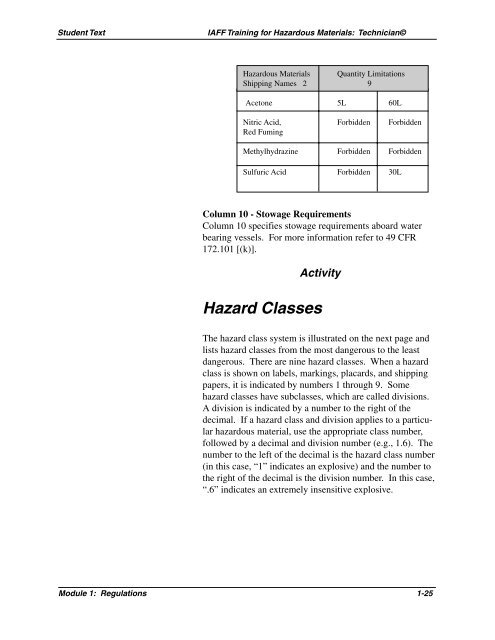Module 1: Regulations - International Association of Fire Fighters
Module 1: Regulations - International Association of Fire Fighters
Module 1: Regulations - International Association of Fire Fighters
Create successful ePaper yourself
Turn your PDF publications into a flip-book with our unique Google optimized e-Paper software.
Student Text IAFF Training for Hazardous Materials: Technician©<br />
Hazardous Materials Quantity Limitations<br />
Shipping Names 2 9<br />
Acetone 5L 60L<br />
Nitric Acid, Forbidden Forbidden<br />
Red Fuming<br />
Methylhydrazine Forbidden Forbidden<br />
Sulfuric Acid Forbidden 30L<br />
Column 10 - Stowage Requirements<br />
Column 10 specifies stowage requirements aboard water<br />
bearing vessels. For more information refer to 49 CFR<br />
172.101 [(k)].<br />
Activity<br />
Hazard Classes<br />
The hazard class system is illustrated on the next page and<br />
lists hazard classes from the most dangerous to the least<br />
dangerous. There are nine hazard classes. When a hazard<br />
class is shown on labels, markings, placards, and shipping<br />
papers, it is indicated by numbers 1 through 9. Some<br />
hazard classes have subclasses, which are called divisions.<br />
A division is indicated by a number to the right <strong>of</strong> the<br />
decimal. If a hazard class and division applies to a particular<br />
hazardous material, use the appropriate class number,<br />
followed by a decimal and division number (e.g., 1.6). The<br />
number to the left <strong>of</strong> the decimal is the hazard class number<br />
(in this case, “1” indicates an explosive) and the number to<br />
the right <strong>of</strong> the decimal is the division number. In this case,<br />
“.6” indicates an extremely insensitive explosive.<br />
<strong>Module</strong> 1: <strong>Regulations</strong> 1-25
















